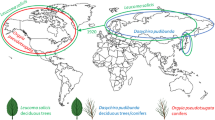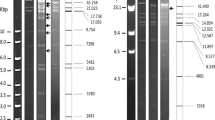Abstract
The Lymantria obfuscata Walker (Lyob) multiple (M) nucleopolyhedrovirus (NPV) (LyobMNPV) has been isolated and successfully applied for the management of the Indian gypsy moth, L. obfuscata in Jammu and Kashmir (J&K), India. The present work aimed to investigate the variability of LyobMNPV isolates from six localities of J&K through molecular [amplification of the polyhedrin (polh), late expression factor-8 (lef-8) and late expression factor-9 (lef-9) genes] and biological (bioassays) characterization. To identify the position of LyobMNPV in the phylogenetic tree of baculoviruses, partial sequences of the polh, lef-8 and lef-9 genes were determined by using the DNA sequences within their coding regions by optimizing the polymerase chain reaction with degenerate primers. The sequence alignment revealed that LyobMNPV isolates exhibited seven, five and eleven single nucleotide polymorphic sites in the case of polh, lef-8 and lef-9, respectively. The phylogenetic analyses supported placing LyobMNPV with the Lymantria dispar L. MNPV (LdMNPV) isolates from different countries, and showed that it was more closely related to LdMNPV than to Lymantria xylina Swinhoe NPV and Lymantria monacha L. NPV. The contaminated diet plug bioassays using 2nd instar larvae indicated that the median lethal dose (LD50) and median survival time (ST50) of different isolates of LyobMNPV against L. obfuscata were lower than those of LdMNPV against L. dispar. LyobMNPV was more closely related to LdMNPV but its LD50 and ST50 were lower than those of LdMNPV. The study provides novel information on the position of LyobMNPV in the phylogenetic tree of baculoviruses and about biological and genetic variation of Lymantria species’ NPV isolates from different parts of the world.



Similar content being viewed by others
References
Bonsall MB (2004) The impact of disease and pathogens on insect populations dynamics. Physiol Entomol 29:223–236
Brandt JP (1994) Gypsy moth. Northern Forestry Centre. Forestry (leaflet) vol. 29. Canadian Forest Service, Natural Resources Canada, Edmonton, Alberta, Canada (available at: http://cfs.nrcan.gc.ca/factsheets/gypsy-moth-nofc/cat.entomology). Accessed 17 Apr 2017
Cowan P, Bulach D, Goodge K, Robertson A, Tribe DE (1994) Nucleotide sequence of the polyhedrin gene of Helicoverpa zea single nucleocapsid nuclear polyhedrosis virus: placement of the virus in lepidopteran nuclear polyhedrosis virus group II. J Gen Virol 75:3211–3218
Croizier G, Ribeiro HCP (1992) Recombination as a possible major cause of genetic heterogeneity in Anticarsia gemmatalis nuclear polyhedrosis virus populations. Vir Res 26:183–196
Crook NE (1981) A comparison of the granulosis viruses from Pieris brassicae and Pieris rapae. Virology 115:173–181
Dharmadhikari PR, Ramaseshiah G, Achan PD (1985) Survey of Lymantria obfuscata and its natural enemies in India. Entomophaga 30:399–408
Duan LQ, Otvos IS, Xu LB, Conder N, Wang Y (2011) Comparison of the activities of three LdMNPV isolates in the laboratory against the Chinese strain of Asian gypsy moth. Open Entomol J 5:24–30
Eberle KE, Sayed S, Rezapanah M, Shojai-estabragh S, Jehle JA (2009) Diversity and evolution of the Cydia pomonella granulovirus. J Gen Virol 90:662–671
Erlandson MA (2009) Genetic variation in field population of baculoviruses: mechanisms for generating variation and its potential role in baculovirus epizootiology. Virol Sin 24:458–469
Fauquet CM, Fargette D (2005) International Committee on Taxonomy of Viruses (ICTV) and the 3,142 unassigned species. Virol J 2:64
Felsenstein J (1985) Confidence limits on phylogenies: an approach using the bootstrap. Evolution 39:783–791
Fuxa JR (2004) Ecology of insect nucleopolyhedroviruses. Agric Ecosyst Environ 103:27–43
Gries R, Paul W, Schaefer Hahn R, Khaskin G, Ramaseshiah G, Singh B, Gagandeep K, Hehar Gries G (2007) Sex pheromone components of Indian gypsy moth, Lymantria obfuscata. J Chem Ecol 33:1774–1786
Grisdale DG (1969) A method for reducing the incidence of virus infection in insect rearing. J Invertebr Pathol 10:425
Gupta RK, Gani M, Jasrotia P, Srivastava K (2013) Development of the predator Eocanthecona furcellata on different proportions of nucleopolyhedrovirus infected Spodoptera litura larvae and potential for predator dissemination of virus in the field. Biocontrol 58:543–552
Gupta RK, Gani M, Kaul V, Bhagat RM, Bali K, Samnotra RK (2016) Field evaluation of Lymantria obfuscata multiple nucleopolyhedrovirus for the management of Indian gypsy moth in Jammu and Kashmir, India. Crop Prot 80:149–158
Hall TA (1999) BioEdit: a user-friendly biological sequence alignment editor and analysis program for Windows 95/98/NT. Nucleic Acids Symp Ser 41:95–98
Harrison RL, Keena MA, Rowley DL (2014) Classification, genetic variation and pathogenicity of Lymantria dispar nucleopolyhedrovirus isolates from Asia, Europe, and North America. J Invertebr Pathol 116:27–35
Herniou EA, Luque T, Chen X, Vlak JM, Winstanley D, Cory JS, O’Reilly DR (2001) Use of whole genome sequence data to infer baculovirus phylogeny. J Virol 75:8117–8126
Herniou EA, Olszewski JA, Cory JS, O’Reilly DR (2003) The genome sequence and evolution of baculoviruses. Annu Rev Entomol 48:211–234
Herniou EA, Olszewski JA, O’Reilly DR, Cory JS (2004) Ancient coevolution of baculoviruses and their insect hosts. J Virol 78:3244–3251
Jehle JA, Blissard GW, Bonning BC, Cory JS, Herniou EA, Rohrmann GF, Theilmann DA, Theim SM, Vlak JM (2006a) On the classification and nomenclature of baculoviruses: a proposal for revision. Arch Virol 151:1257–1266
Jehle JA, Lange M, Wang H, Hu Z, Wang Y, Hauschild R (2006b) Molecular identification and phylogenetic analysis of baculoviruses from Lepidoptera. Virology 346:180–193
Keena MA, Wallner WE, Grinberg PS, Carde RT (2001) Female flight propensity and capability in Lymantria dispar (Lepidoptera: Lymantriidae) from Russia, North America, and their reciprocal F1 hybrids. Environ Entomol 30:380–387
Kuzio J, Pearson MN, Harwood SH, Funk CJ, Evans JT, Slavicek JM, Rohrmann GF (1999) Sequence and analysis of the genome of a baculovirus pathogenic for Lymantria dispar. Virology 253:17–34
Lacey LA, Frutos R, Kaya HK, Vail P (2001) Insect pathogens as biological control agents: do they have a future?. Biol Control 21:230–248
Lange M, Wang H, Zhihong H, Jehle JA (2004) Towards a molecular identification and classification system of lepidopteran-specific baculoviruses. Virology 325:36–47
Magnoler A (1970) Susceptibility of gypsy moth larvae to Lymuntria spp, nuclear and cytoplasmic-polyhedrosis viruses. Entomophaga 15(4):407–412
Martin DW, Weber PC (1997) DNA replication promotes high-frequency homologous recombination during Autographa californica multiple nuclear polyhedrosis virus infection. Virology 232:300–309
Munshi N, Hussain B, Malik G, Yousuf M, Fatima N (2008) Efficacy of entomopathogenic fungus Fusarium pallidoroseum (Cooke) Sacc. against gypsy moth (Lymantria obfuscata Walker). J Entomol 5:59–61
Nielsen CB, Cooper D, Short SM, Myers JH, Suttle CA (2002) DNA polymerase gene sequences indicate western and forest tent caterpillar viruses form a new taxonomic group within baculoviruses. J Invertebr Pathol 81:131–147
Organisation for Economic Cooperation and Development (OECD) (2002) Consensus document on information used in the assessment of environmental applications involving baculoviruses. Series on harmonisation of regulatory oversight in biotechnology no. 20. Head of publications, OECD, Paris, pp 11–90
Rabindra RJ (2001) Identfication of baculoviruses by restriction endonuclease analysis. In: Rabindra RJ, Kennedy JS, Sathiah N, Rajasekharam B, Srinivas M R (eds) Microbial control of crop pests. Tamil Nadu Agricultural University, Coimbatore, India, pp 110–115
Redman EM, Wilson K, Grzywacz D, Cory JS (2010) High levels of genetic diversity in Spodoptera exempta NPV from Tanzania. J Invertebr Pathol 105:190–193
Rishi ND, Shah KA (1985) Survey of bio-ecological studies on the natural enemies of Indian gypsy moth Lymantria obfuscata Walker (Lepidoptera: Lymantriidae). J Entomol Res 9:82–93
Saitou N, Nei M (1987) The neighbor-joining method: a new method for reconstructing phylogenetic trees. Mol Biol Evol 4:406–425
Schaefer PW, Weseloh RM, Sun X, Wallner WE, Yan J (1984) Gypsy moth, Lymantria (=Ocneria) dispar (L.) (Lepidoptera: Lymantriidae), in the People’s Republic of China. Environ Entomol 13(6):1535–1541
Shapiro M, Robertson JL (1991) Natural variability of three geographic isolates of gypsy moth (Lepidoptera: Lymantriidae) nuclear polyhedrosis virus. J Econ Entomol 84:71–75
Singh S, Moore SD, Spillings B, Hendry D (2003) South African isolate of Cryptophlebia leucotreta granulovirus. J Invertebr Pathol 83:249–252
Singh R, Kumar S, Chakrabarti S, Kumar A (2007) Resurgence of Indian gypsy moth, Lymantria obfuscata Walker (Lepidoptera: Lymantriidae) on ban oak (Quercus leucotrichophora) forests in Rajgarh Forest Division, Himachal Pradesh. Ind J Forest 30:83–85
Stockhoff BA (1993) Ontogenetic change in dietary selection for protein and lipid by gypsy moth larvae. J Insect Physiol 39:677–686
Takatsuka J, Okuno S, Nakai M, Kunimi Y (2003) Genetic and biological comparisons of ten geographic isolates of a nucleopolyhedrovirus that infect Spodoptera litura (Lepidoptera: Noctuidae). Biol Cont 26:32–39
Tamura K, Stecher G, Peterson D, Filipski A, Kumar S (2013) MEGA6: molecular evolutionary genetics analysis version 6.0. Mol Biol Evol 30:2725–2729
Thakur B, Chakrabarti S, Kumar M (2015) Detailed larval biology of Indian gypsy moth Lymantria obfuscata Walker on Quercus leucotrichophora Roxb. in Himachal Pradesh (India). AIJRFANS 10:31–34
Acknowledgements
The authors are grateful to Dr H. C. Sharma, Principal Scientist, ICRISAT and President of the International Congress of Entomology for critical reading of the manuscript. Suggestions and guidance by Dr. S. K. Jalali and Dr Nagesh Madandi are acknowledged. Our sincere thanks are due to the Department of Science and Technology, Government of India (DST/INSPIRE FELLOWSHIP/2012/308) for funding and to the NBAIR for technical support.
Author information
Authors and Affiliations
Corresponding author
Electronic supplementary material
Below is the link to the electronic supplementary material.
Rights and permissions
About this article
Cite this article
Gani, M., Gupta, R.K., Zargar, S.M. et al. Molecular identification and phylogenetic analyses of multiple nucleopolyhedrovirus isolated from Lymantria obfuscata (Lepidoptera: Lymantriidae) in India. Appl Entomol Zool 52, 389–399 (2017). https://doi.org/10.1007/s13355-017-0490-3
Received:
Accepted:
Published:
Issue Date:
DOI: https://doi.org/10.1007/s13355-017-0490-3




